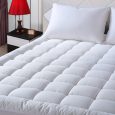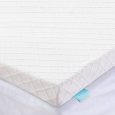If you find yourself waking up with persistent body aches and discomfort, it may be time to consider using pressure-relieving mattress toppers. Designed specifically to alleviate pressure points and promote better sleep, these mattress toppers offer a simple yet effective solution to your body pain. By redistributing your body weight evenly and providing extra support, they can help reduce the strain on your muscles and joints, allowing you to wake up feeling refreshed and pain-free. Say goodbye to restless nights and hello to a more comfortable, rejuvenating sleep experience with the help of pressure-relieving mattress toppers.
Benefits of Pressure-Relieving Mattress Toppers
Improved Sleep Quality
A pressure-relieving mattress topper can significantly improve your sleep quality by providing enhanced comfort and support. These toppers are designed to distribute your body weight evenly, reducing pressure points that can cause discomfort and pain. With less tossing and turning throughout the night, you can enjoy a more restful and uninterrupted sleep, allowing you to wake up feeling refreshed and rejuvenated.
Reduced Pressure Points
One of the key benefits of using a pressure-relieving mattress topper is the reduction of pressure points on your body. These toppers are typically made from materials that conform to the shape of your body, such as memory foam or latex. By evenly distributing your weight, they help to alleviate pressure on specific areas like your shoulders, hips, and knees. This can be especially beneficial for individuals who suffer from chronic pain or those who are prone to developing pressure sores.
Enhanced Spinal Alignment
Maintaining proper spinal alignment is crucial for a healthy and comfortable sleep. A pressure-relieving mattress topper can help achieve optimal alignment by providing adequate support to your spine. The topper’s contouring properties help align your spine in a neutral position, reducing the risk of developing back pain or exacerbating existing spinal conditions such as scoliosis or herniated discs. It promotes a healthy sleep posture, allowing your muscles to relax and recover during the night.
Better Blood Circulation
When you lie down on a traditional mattress, there can be areas that experience restricted blood flow due to pressure points or lack of support. This can lead to discomfort and numbness in those regions, causing you to shift positions frequently for relief. A pressure-relieving mattress topper helps improve blood circulation by reducing pressure points and evenly distributing your weight. With improved circulation, you can avoid numbness and discomfort, allowing you to sleep peacefully throughout the night.
Reduced Tossing and Turning
Have you ever found yourself constantly tossing and turning, trying to find a comfortable position to sleep in? A pressure-relieving mattress topper can help minimize this issue by providing a supportive and contouring surface. By reducing pressure points and promoting proper alignment, the topper eliminates the need for constant movement to find relief. This can result in more restful sleep, leaving you feeling more refreshed and energized in the morning.
Factors to Consider When Choosing a Pressure-Relieving Mattress Topper
Material and Construction
When selecting a pressure-relieving mattress topper, it’s essential to consider the material and construction. Memory foam toppers are known for their contouring properties and ability to relieve pressure points. However, latex toppers offer similar benefits with a more responsive and bouncy feel. Gel-infused toppers are ideal for hot sleepers as they provide enhanced cooling properties. Egg-crate toppers offer a unique texture that can relieve pressure points, while feather and down toppers provide a plush and luxurious feel.
Thickness and Density
The thickness and density of the mattress topper play a significant role in its ability to relieve pressure points effectively. A thicker topper generally provides more cushioning and support, especially for individuals with heavier body weight or those in need of extra comfort. Density refers to the weight and durability of the topper. Higher density foams are more durable and better at providing support, while lower density foams tend to be softer and offer more contouring.
Body Weight and Sleeping Position
Your body weight and preferred sleeping position should also be taken into consideration when choosing a pressure-relieving mattress topper. Side sleepers may benefit from a topper that offers extra pressure relief for the hips and shoulders. Back and stomach sleepers may require a medium-firm topper for optimal spinal alignment. Additionally, individuals with heavier body weight may prefer a thicker and more supportive topper to prevent sinking too deeply into the mattress.
Heat Regulation
Heat regulation is crucial for a comfortable night’s sleep, especially if you tend to sleep hot. Some mattress toppers, such as gel-infused or open-cell memory foam, are designed to dissipate heat and provide a cooler sleeping surface. Other materials like latex and feather/down toppers offer natural breathability, allowing for better airflow and temperature regulation. If you struggle with overheating during the night, it’s important to choose a mattress topper that addresses this issue.
Durability
Investing in a durable pressure-relieving mattress topper is essential for long-term satisfaction. The durability of a topper depends on the quality of materials and construction. High-density memory foam or latex toppers tend to be more durable and better at maintaining their shape over time. Additionally, it’s important to choose a topper that comes with a warranty to protect against manufacturing defects and premature wear.
Types of Pressure-Relieving Mattress Toppers
Memory Foam Toppers
Memory foam toppers are a popular choice for pressure relief as they contour to the shape of your body, alleviating pressure points. They provide excellent support and can help improve spinal alignment. Memory foam toppers come in various thicknesses and densities, allowing you to choose the level of comfort and support that suits your needs.
Latex Toppers
Latex toppers are known for their natural responsiveness and durability. They offer a more buoyant and bouncy feel compared to memory foam. Latex toppers provide exceptional pressure relief and are often recommended for individuals with allergies or sensitivities, as they are resistant to dust mites and mold. They also have excellent heat regulation properties, keeping you cool throughout the night.
Gel-infused Toppers
Gel-infused mattress toppers combine the pressure-relieving properties of memory foam with enhanced cooling capabilities. The gel beads infused into the foam help dissipate heat and regulate temperature, making them an excellent choice for hot sleepers. Gel-infused toppers contour to your body and relieve pressure points, providing a comfortable and supportive sleep surface.
Egg-crate Toppers
Egg-crate mattress toppers have a unique textured surface that resembles an egg carton. This texture helps reduce pressure points and provides gentle support. Egg-crate toppers are a more affordable option for pressure relief, but they may not offer the same level of comfort and durability as memory foam or latex toppers.
Feather and Down Toppers
Feather and down mattress toppers provide a luxurious and plush sleeping surface. They offer excellent softness and contouring properties. Feather and down toppers are ideal for those who prefer a cloud-like feel and enjoy a softer sleep surface. However, they may not provide the same level of pressure relief as foam or latex toppers.
How to Use a Pressure-Relieving Mattress Topper
Place the Topper on Your Mattress
To use a pressure-relieving mattress topper, start by placing it on top of your existing mattress. Ensure that the topper aligns with the edges of your mattress and lies flat without any wrinkles or folds.
Secure it with Fitted Sheets
To prevent the topper from moving around during the night, it’s recommended to secure it with fitted sheets. Choose sheets that are deep enough to accommodate the additional height of the topper. This will help keep the topper in place and ensure a secure and comfortable sleep surface.
Allow Time for Expansion and Off-gassing
Some mattress toppers, especially those made of memory foam, may need time to expand and off-gas after unpacking. Follow the manufacturer’s instructions regarding the recommended waiting period before use. This will allow the topper to reach its full size and air out any initial odors.
Maintain and Clean the Topper Regularly
Regular maintenance and cleaning are essential for keeping your pressure-relieving mattress topper in optimal condition. Follow the manufacturer’s instructions for cleaning and care, which may involve spot cleaning or hand washing. Use a mattress protector to prevent stains and spills from reaching the topper, and rotate the topper periodically to ensure even wear.
Replace when Necessary
While pressure-relieving mattress toppers can provide long-lasting comfort and support, they may eventually need to be replaced. If you notice a significant decrease in its effectiveness or visible signs of wear and tear, it may be time to invest in a new topper. Replace your topper when it no longer provides adequate support or fails to relieve pressure points as effectively as before.
Who Can Benefit from Using Pressure-Relieving Mattress Toppers
People with Chronic Body Aches
If you suffer from chronic body aches, a pressure-relieving mattress topper can provide much-needed relief. By reducing pressure points and promoting proper spinal alignment, these toppers can alleviate pain and discomfort, allowing you to wake up feeling refreshed and rejuvenated.
Side Sleepers
Side sleepers often experience increased pressure on their hips and shoulders, which can lead to pain and discomfort. A pressure-relieving mattress topper can help distribute the weight evenly, reducing pressure points and providing the necessary support for side sleeping.
Pregnant Women
During pregnancy, the body undergoes significant changes, leading to increased pressure and discomfort in various areas. A pressure-relieving mattress topper can help alleviate the strain on the back, hips, and joints, providing a more comfortable sleep for pregnant women.
Elderly Individuals
As we age, our bodies become more susceptible to aches and pains, particularly in the joints and muscles. Elderly individuals can benefit from the pressure-relieving properties of mattress toppers, which can help alleviate discomfort and improve overall sleep quality.
People Recovering from Injuries or Surgeries
For individuals recovering from injuries or surgeries, pressure-relieving mattress toppers can provide the necessary support and comfort needed for a restful sleep. They help reduce pressure on sensitive areas and aid in the healing process, allowing for a faster and smoother recovery.
Case Studies: Personal Experiences with Pressure-Relieving Mattress Toppers
John’s Journey to a Pain-Free Sleep
John had been suffering from chronic lower back pain for years, making it difficult for him to get a good night’s sleep. He decided to try a pressure-relieving mattress topper after hearing positive reviews from friends. To his surprise, the topper provided immediate relief. The memory foam conformed to his body, reducing pressure points and aligning his spine. John’s quality of sleep improved significantly, and he woke up feeling less tense and achy.
Sarah’s Relief from Pregnancy Discomfort
Sarah was in her third trimester of pregnancy and was experiencing increasing discomfort and pain in her hips and lower back. Her doctor recommended trying a pressure-relieving mattress topper to alleviate the strain on her body. Sarah found that the topper provided excellent support and reduced the pressure on her joints. She was able to sleep more comfortably and wake up feeling less sore and fatigued.
Mike’s Recovery from a Sports Injury
Mike had recently undergone knee surgery and was struggling with pain and limited mobility. His physical therapist suggested using a pressure-relieving mattress topper to aid in the healing process. The topper helped distribute his weight evenly and reduced pressure on his surgical area. Mike noticed a significant improvement in his sleep quality, allowing his body to recover more effectively.
Potential Drawbacks of Pressure-Relieving Mattress Toppers
Initial Off-gassing Odor
Some pressure-relieving mattress toppers, particularly those made of memory foam, may emit a noticeable odor when first unpacked. This off-gassing odor is temporary and typically dissipates within a few days. To minimize the smell, it’s recommended to allow the topper to air out in a well-ventilated area before use.
Limited Longevity
While pressure-relieving mattress toppers can provide significant comfort and support, they may not last as long as a full mattress. Depending on the quality of materials and construction, a topper’s lifespan can range from a few years to a decade. It’s important to consider the durability of the topper before making a purchase.
Temperature Regulation Challenges
Some mattress toppers, particularly those made of memory foam, have a reputation for trapping heat and causing sleepers to feel too warm. While advancements have been made in temperature regulation technology, it’s important to choose a topper that addresses this concern, especially if you tend to sleep hot.
Not Suitable for All Mattress Types
Pressure-relieving mattress toppers are generally designed to be compatible with most standard mattress types. However, it’s essential to ensure that the topper size matches your mattress size. Additionally, certain mattress types, such as waterbeds or airbeds, may not be well-suited for the use of mattress toppers.
Adjustment Period
It’s important to note that some individuals may require an adjustment period when first using a pressure-relieving mattress topper. Your body may need time to adapt to the new sleeping surface and support provided by the topper. Give yourself a few nights to determine if the topper is suitable for your needs before making a final judgment.
Frequently Asked Questions about Pressure-Relieving Mattress Toppers
How long do pressure-relieving mattress toppers last?
The lifespan of a pressure-relieving mattress topper varies depending on factors such as the quality of materials, usage, and maintenance. On average, a high-quality topper can last anywhere from 3 to 7 years. However, it’s important to assess the condition of the topper regularly and replace it when signs of wear and tear are evident.
Are they suitable for people with allergies?
Yes, pressure-relieving mattress toppers can be suitable for individuals with allergies. Latex toppers, in particular, are naturally hypoallergenic and resistant to dust mites and mold. However, it’s important to check the specifications and ensure that the topper is certified as hypoallergenic to avoid any potential allergic reactions.
Can I use a mattress pad over the topper?
Yes, you can use a mattress pad over a pressure-relieving mattress topper. A mattress pad can help protect the topper from spills, stains, and general wear. However, it’s important to choose a mattress pad that is compatible with the thickness of the topper to ensure a secure fit and maximum comfort.
Do they come with a warranty?
Many pressure-relieving mattress toppers come with a warranty, providing coverage against manufacturing defects and premature wear. The length and terms of the warranty can vary between manufacturers, so it’s important to review the warranty information before making a purchase.
Can they be used on adjustable beds?
Pressure-relieving mattress toppers are generally compatible with adjustable beds. However, it’s important to ensure that the topper is the appropriate size and thickness to accommodate the range of motion of the adjustable bed. Additionally, if your adjustable bed uses a specific type of mattress (such as memory foam or latex), it’s recommended to choose a topper that complements the mattress type for optimal comfort and support.
Alternative Methods for Alleviating Body Aches
Choosing the Right Mattress
In addition to using a pressure-relieving mattress topper, choosing the right mattress can also contribute to alleviating body aches. Consider a mattress that offers proper support and comfort, taking into account your specific needs and preferences. Firmness levels, mattress types, and materials can all affect your sleep quality and relieve body aches.
Proper Sleep Posture and Alignment
Maintaining proper sleep posture and alignment is crucial for minimizing body aches. Ensure that your mattress, pillow, and sleeping position all support neutral spinal alignment. Avoid sleeping on your stomach, as this can strain your neck and back. Instead, opt for side or back sleeping positions and use pillows or cushions for additional support if necessary.
Regular Exercise and Stretching
Engaging in regular exercise and stretching can help alleviate body aches by improving muscle strength and flexibility. Regular physical activity promotes blood circulation, reduces inflammation, and releases endorphins, which can help relieve pain and promote a sense of well-being. Consult with a healthcare professional to determine suitable exercises and stretches for your specific needs.
Physical Therapy and Massage
For individuals experiencing chronic or severe body aches, physical therapy or massage therapy may be beneficial. These treatments can target specific areas of pain, promote proper alignment and muscle balance, and provide targeted pain relief. Consult with a healthcare professional to determine if these therapies are suitable for your condition.
Pain Medication and Supplements
In some cases, over-the-counter or prescription pain medication may be necessary to manage body aches. Nonsteroidal anti-inflammatory drugs (NSAIDs) and other pain relievers can provide temporary relief, but it’s important to consult with a healthcare professional before relying on medication long-term. Additionally, certain supplements, such as omega-3 fatty acids or turmeric, may have anti-inflammatory properties and can be incorporated into your routine to ease body aches.
Conclusion
Pressure-relieving mattress toppers offer a range of benefits for individuals seeking relief from body aches and improved sleep quality. By reducing pressure points, enhancing spinal alignment, and promoting better blood circulation, these toppers can provide a comfortable and supportive sleep surface. Factors such as material and construction, thickness and density, body weight and sleeping position, heat regulation, and durability should be considered when choosing a topper. When used correctly, pressure-relieving mattress toppers can offer long-lasting comfort and aid in alleviating body aches for a restful night’s sleep.







